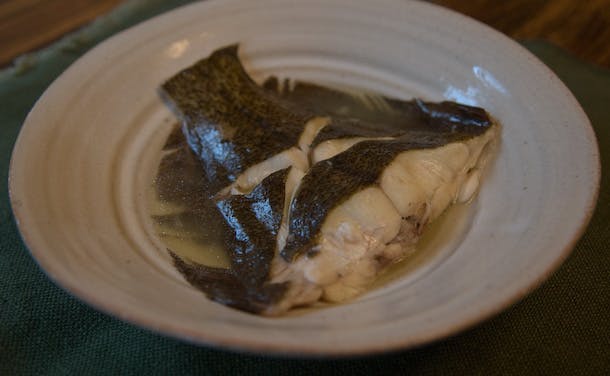
Sake and Salt Poached Flounder
Learn the traditional Japanese cooking method for preparing flounder, poached in sake and salt. Discover the technique of using otoshibuta and the significance of cutting the ingredients for enhancing flavor. This recipe from Atsushi Nakahigashi results in a simple and utterly sublime dish, perfect for showcasing the delicate flavors of flounder.
At the farmers market, Chef Atsushi Nakahigashi and I spotted local Long Island Sound flounder, in peak season right now. I asked him how to prepare this delicately fish and he suggested poaching it in sake and salt, a simple method to subtly and elegantly express its flavors. We picked up a bunch, iced them down, and brought them over to Chef Tadashi Ono's house to prepare for his family (hey, I wan't the only enjoying Atsushi's cooking!).
Japanese cooking fundamentals I learned watching Atsushi prepare this dish: When he sliced the whole flounder into pieces, Atsushi sliced it on a sharp angle (maybe 45 degrees). The reason is twofold. First, Chef Ono explained that cutting this way exposes more surface area of the flesh to the cooking liquid, so the liquid can penetrate deeper inside the fish and the flesh can absorb more flavor. And second, Atsushi added, a piece of flounder cut this way looks bigger, which is more pleasing aesthetically. So, in short, how you cut the ingredients influences how it will taste.
Also, Atsushi fashioned a makeshift otoshibuta from aluminum foil to place on top of the flounder. An otoshibuta is an invaluable tool of Japanese cooking, a drop-lid smaller in diameter than a cooking pot, so it rests directly on top of ingredients simmered in liquid. In Japan otoshibuta are traditionally made from wood, but aluminum foil works well, too. An otoshibuta serves a number of roles, Chef Ono explained to me: First, it keeps ingredients from moving around while they cook, so they don't break up. Second it concentrates the heat directly into ingredients so they cook more efficiently. And finally, it forces the liquid and flavors to circulate inside the pot, so they coat and infuse ingredients.
Flounder Poached in Sake with Konbu
Ingredients:
- Flounder, sliced into pieces
- Sake
- Salt
- 4-inch piece of Konbu
Instructions:
- Prepare the Flounder: On each slice of flounder, cut an "X" through the skin. This technique helps the cooking liquid and flavors penetrate the flesh and prevents the skin from shriveling.
- Arrange the Flounder: In a pot, arrange the flounder slices skin side up. Place the konbu over the fish.
- Add Sake: Pour sake into the pot until it halfway covers the fish. Avoid fully immersing the fish in sake.
- Season: Liberally salt the flounder.
- Cover with Otoshibuta: Gently place an aluminum foil otoshibuta (foil lid) directly on the fish, ensuring it fits loosely over the fish rather than tightly.
- Cook: Turn the heat to high. Once the liquid boils, reduce to medium and let it simmer. Observe the liquid bubbling from the edges of the otoshibuta.
- Adjust Seasoning: After a few minutes, taste the liquid. You may want to add more salt based on your taste preferences.
- Finish Cooking: After about ten minutes, the fish should be cooked through and feel firm to the touch.
- Serve: Carefully transfer the fish onto plates with a spatula and spoon the sake-konbu broth over it.
Techniques and Their Purposes:
- Cutting an "X" on the Fish: Enhances flavor absorption and prevents skin shrinkage during cooking.
- Halfway Immersion in Sake: Allows for a gentle poaching, infusing the fish with sake's delicate flavors without overwhelming it.
- Using Konbu: Adds umami and depth to the broth, enriching the overall flavor of the dish.
- Loose Otoshibuta Placement: Encourages even cooking and prevents the fish from drying out, while allowing it to steep in the aromatic broth.
- Simmering: Gently cooks the fish, ensuring it remains tender and infused with the broth's flavors.
- Tasting and Seasoning: Allows for flavor adjustment to ensure the broth complements the fish perfectly.
Atushi told me that this technique works exceptionally well with flounder because of the particular nature of that fish. With other fish, the salt may extract its juices and toughen it, actually.
